![]()
![]()
![]()
Use LEFT and RIGHT arrow keys to navigate between flashcards;
Use UP and DOWN arrow keys to flip the card;
H to show hint;
A reads text to speech;
31 Cards in this Set
- Front
- Back
|
Gas exchange |
Uptake O2 and exhaling CO2 |
|
|
Partial pressure |
Pressure exerted by a particular gas in a mix of gases (also applies to gas dissolved in liquid) O2 is much less soluble in water than in air Gases undergo net diffusion from region of higher pp t area of lower pp ie: at sea level, the pressure of a column of atomosphere above us is 760 mm Hg. Atmosphere is 21% O2, 78% N2, and .04% CO2. O2 is 160 mmHg, N2 is 365 mmHg |
|
|
Realities media |

Breathing air is relatively easy and need not be very efficient In a given volume, there is less O2 available in water than in air, concentration of O2 is lower in water than air (temp and salt impact this) Obtaining O2 from water requires greater efficiency |
|
|
Respiratory surfaces |
Need large wet respiratory surfaces to exchange gases through diffusion( rate of diff. Is proportional to SA: the bigger, the faster) Also need thin tissue Respiratory surfaces vary by animal and can include skin gills trachea and lungs |
|
|
Gills in aquatic animals |
Gills are out folding of the body that create large SA for gas exchange Ventilation moves respiratory medium over respiratory surfaces (swimming or brushing water over gills) |
|
|
Countercurrent exchange |

Used in fish gills Blood flows in opposite direction of water passing over gills Blood is always less saturated with O2 than the water it meets (this allows for higher pp to lower pp diffusion) More than 80% of O2 dissolved in the water is removed as water passes over respiratory surface (allows super efficient) |
|
|
Tracheal systems in insects |
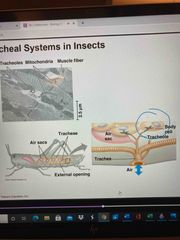
Have opening to outside and it branches inside that have cells attached to absorb (no blood absorbing) |
|
|
Lungs |
Unfolding of body surface Circulatory system transports gases btw lungs and body Size and complexity correlated with animals anabolic rate (horse lungs are huge) |
|
|
Process of air travel |
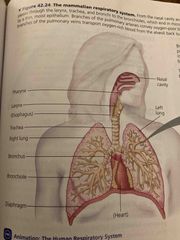
1. Filters through nose, warms it, humidified it, and samples odors 2. Pharynx directs air to the lungs and food to stomach (swallowing or breathing). Larynx moves upward and tips the epiglottis over the glottis to keep food from trachea |
|
|
Air travels cont |
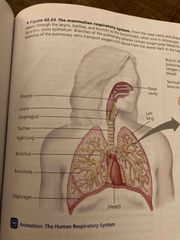
3. Air passes 1. Pharynx 2. Larynx 4. Trachea 5. Bronchi 6. Bronchioles 7. Alveoli (where gas exchange occurs) There is cartilage around trachea to hold windpipe open |
|
|
Larynx |
Just beyond the pharynx at top of trachea Holds vocal cords (strips of elastic tissue that vibrate to create sound) Cilia and mucus line epithelium of air ducts and move particles up to the pharynx Mucus elevator: take particles that breathe in and move them up to dump into esophagus to be swallowed |
|
|
Alveoli |
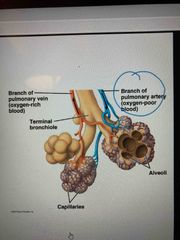
Place of gas exchange Air sacs at the tips of bronchioles (1,000 square feet) Oxygen diffuses through the moist film of epithelium and into capillaries (inside alveoli) Simple squamous epithelium. Thin due to only diffusion Capillaries netting around alveoli CO2 diffuses from the capillaries and into air space to exhale it |
|
|
Surfactants |
Secretions that coat surface of alveoli (disrupt surface tension) Alveoli are so thin that they would collapse on themselves so they have surfactant Alveoli are susceptible. They lack cilia and have whit blood cells, but too much is a problem (smoking, dust, and so on) |
|
|
Babies and surfactants |
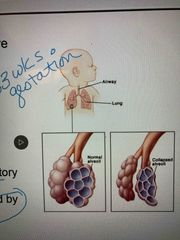
Doesn’t develop until 33 weeks Babes born premature do not have so at risk of realities distress syndrome they will tx with artificial surfactant now |
|
|
Positive pressure breathing |
Amphibians Forces air down trachea |
|
|
Birds breathing |
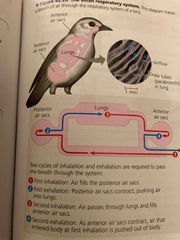
Have multiple sacs (8-9) Breathe in twice to move air through so they don not mix spent air with fresh air Highly efficient |
|
|
Negative pressure breathing |
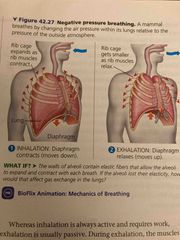
Pulls air in Long volume increases as rib and diaphragm muscles contract Lungs are enclosed by plural sac sticking together lung and inside of thoracic cavity When expanded this creates reduces pressure so from outside will come in to lower pressure They relax on exhale creating pressure to move out CO2 |
|
|
Breathing |
Tidal volume: volume inhaled with each breath (500mL) Vital capacity: max tidal volume (w-3.4 L, m-a little more) Residual volume: after exhalation, amount of air left in lungs |
|
|
Control of breathing |

Breathing is regulated involuntary breathing Control centers found in the medulla oblongata Medulla regulates the rate and depth of breathing in response to pH changes in cerebrospinal fluid Also have stretch receptors that tell lungs you breathed enough |
|
|
How the medulla oblongata regulates breath |
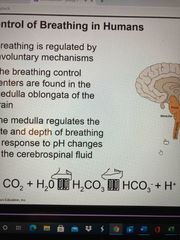
Increase CO2 due to cellular respiration, you make a lot of acid The more CO2 you have, the more carbonic acid you make which then makes your pH in your blood drop This then drops in your cerebrospinal fluid also so MO increases rate and depth of breath to bring in more O2 as well as get rid of CO2 on more exhales More O2 helps for more metabolism as well |
|
|
Additional sensors |
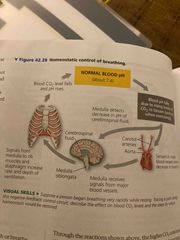
Sensors in aorta and carotid arteries monitor O2 and CO2 concentrations in blood These signal breath controls Additional moldulation of breathing in the pons, next to medulla and is involved with tempo |
|
|
Circulation and gas exchange |
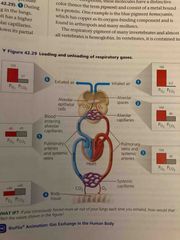
1. Breathe in air, mix with air in lungs, has higher pO2. (160 to .2) 2. In alveoli, O2 moves to blood (in capillaries bc it has 40:45 ratio and higher to lower) and CO2 moves to air. It is now 104:40 ratio. 3. Blood goes from pulmonary vein to the heart and then to the body (systemic capillaries) 4. Exchange in capillaries of O2 and CO2 bc O2 diffuses to tissues and tissues give CO2 (think of cellular respiration and mitochondria). Ratio is now 40:45. 5. Travels the pulmonary arteries to the heart and then to the lungs where CO2 is exhaled again diffuses from higher to lower
|
|
|
Respiratory pigments |
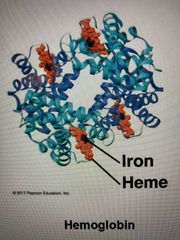
Proteins that help carry oxygen, increasing amount of oxygen that blood can carry Exercising person would need to dissolve 2 L of blood per minute to get O2.=555 pumps per min). Due to these, needs to only pump 12.5 |
|
|
Hemocyanin |
Respiratory pigment that uses copper as the oxygen-binding component In anthropods and molluscsw |
|
|
Hemoglobin |
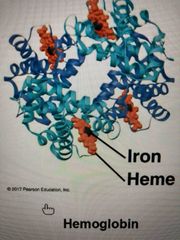
Respiratory pigment in vertebrate and some invertebrates Contained within erythrocytes Can carry 4 molecules of oxygen that bind to iron Does this reversible: grabs on and let’s go of oxygen |
|
|
Dissociation curve of hemoglobin |

Small change in the partial pressure of oxygen can result in large change in delivery of O2 |
|
|
Cooperatively |
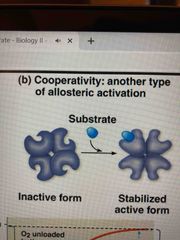
Allosteric regulation Binding of O2 on hemoglobin changes it’s shape which leads to greater affinity to oxygen molecules The reverse is also true. When one releases oxygen, the others release |
|
|
Bohr shift |
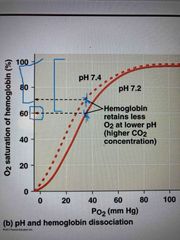
Fold of protein changes due to pH (hemoglobin) when blood pH is more acidic CO2 produced during cellular respiration lowers blood pH and decreases the affinity of hemoglobin for O2 Ventilation is controlled by pH of blood. pH is higher when more CO2 in blood (happens during high cell respiration). Tissues probably need more O2.
|
|
|
Hemoglobin and CO2 transfer |
Hemoglobin assist in transferring CO2 to buffer blood Carries about 7% of CO2. 70% of CO2 is transported in erythrocytes and reacts with water. Dissociates to hydrogen and bicarbonate ions (in buffer form) |
|
|
Adaptations of diving mammals |
Some seals and whales can dive deep and hold breath for about 2 hours Some have a high blood to body volume ratio Stockpile O2 and use it slowly Have myoglobin proteins in muscles Passive moving, keep blood from going to certain parts, and can use fermentation |
|
|
Fetal hemoglobin |

Fetal hemoglobin holds on to oxygen more than adult. Allows fetus to extract oxygen from mother blood |

